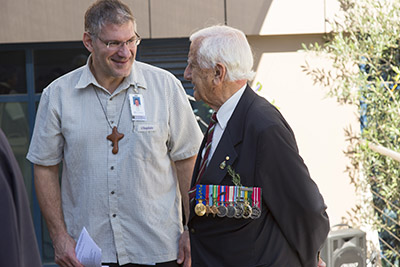 Fifty years to the day Dr Stan Mellick first attended an ANZAC Day service at St Andrew’s War Memorial Hospital in Spring Hill, he will once again take his place at this special occasion, performing the raising and lowering of the flag.
Fifty years to the day Dr Stan Mellick first attended an ANZAC Day service at St Andrew’s War Memorial Hospital in Spring Hill, he will once again take his place at this special occasion, performing the raising and lowering of the flag.
Dr Mellick OAM ED, who served in World War II in the New Guinea campaign, was a long-time member of the St Andrew’s Hospital Board of Governors. The centenary of the ANZAC landings at Gallipoli has particular meaning for Dr Mellick, who is a retired Lieutenant-Colonel.
“ANZAC Day services have always been very important at St Andrew’s because the hospital was established in 1958 as a living memorial to the sacrifices of the men and women who served in the two World Wars and subsequent campaigns.
“Over the years I have attended most ANZAC Day services at the hospital, and have often been asked to raise and lower the flag. It’s been an honour to do so.”
Dr Mellick recalled the close connections between St Andrew's and the military in the early days of the hospital's history.
“When, in the mid-1960s, I was Commanding Officer of Brisbane’s 4 Signal Regiment and, at that time, also serving on the Board of St Andrew's, I realised that the operating theatres had no back-up emergency lighting.
“So I asked the Second in Command of my Regiment, Major Bill Walters, help find the hospital batteries for lighting the theatres if they were needed. From little things big things indeed grow and the batteries were later replaced by the heavy backup equipment now installed.
“As well, I arranged for another Signal Unit to donate a bed so there was a strong link between the hospital and the Corps of Signals. Several members always attended the ANZAC service at the hospital before going to the ANZAC march.”
The keynote speaker at the St Andrew’s ANZAC Day Remembrance Service, which takes place at 2.30pm on Saturday 25 April, is Honorary Colonel Wendy Taylor RAANC.
Mrs Taylor, who is president of the South East District RSL and a retired senior Army Nursing Corps leader, said it would be a privilege to address the St Andrew’s ANZAC service.
“St Andrew’s has had a long connection of supporting veterans, including treating members of the Armed Forces who have served in recent conflicts, such as in the Gulf Wars, East Timor and Afghanistan,” Mrs Taylor said.
St Andrew’s War Memorial Hospital General Manager Andrew Barron said the ANZAC Day service this year meant a great deal to the hospital’s staff, volunteers, patients and supporters.
“This is an historic year, and we still treat many veterans. Our hospital is a place of healing and caring for people, and we approach ANZAC Day in this spirit,” Mr Barron said.
Theo Masselos, manager of the hospital’s Pastoral Care Department, said ANZAC Day was a time-honoured tradition that sought to remember a defining moment in Australia’s history.
“The events at ANZAC Cove, on 25 April 1915, together with every involvement in international military conflict since, have written a story of bravery and mateship in the midst of adversity. Yet it is also a story that we remember soberly because of the cost of life to so many.
“As a living memorial, St Andrew’s remembers, in particular, the Fallen. The ideal of service which they embraced is both honoured and continued at St Andrew's in the caring which is given to all who need it.”